 |
 |
 |
| |
HIV Incidence in Women at Risk for HIV Acquisition in the United States:
HPTN 064 (ISIS Study): 5x higher HIV rates in USA women of color than CDC estimates, comparable to HIV rates in sub-Saharan Africa. Webinar Update see details below.
|
| |
| |
Reported by Jules Levin
CROI 2012 March 5-8 Seattle, WA
Hodder S1, Justman J2, Hughes JP3,4, Wang J4, Haley D5, Adimora A6, Del Rio C7, Soto-Torres L8, Eshleman SH9, and El-Sadr W2, for the HPTN 064 Study Team
1Univ. of Medicine and Dentistry, Newark, NJ, USA; 2ICAP-Columbia Univ., Mailman School of Public Health, Columbia University, NY, USA; 3Fred Hutchinson Cancer Research Center, Seattle, WA, USA; 4University of Washington, Seattle, WA; 5FHI 360, Durham, NC, USA; 6University of North Carolina Schools of Medicine and Gillings School of Global Public Health, Chapel Hill, NC, USA; 7Rollins School of Public Health and Center for AIDS Research, Emory University, Atlanta, GA, USA; 8NIAID, NIH, Bethesda, MD, USA; 9Johns Hopkins Univ. School of Medicine, Baltimore, MD, USA.
Corresponding author: S. Hodder at hoddersa@umdnj.edu.
"Low Income < $10,000, substance use, age 27-33, age 34+, depression, illicit drug use (cocaine, opoid), history of violence/abuse, alcohol, all are factors the higher than expected HIV rates in these communities.". In this study 88% were black women, 12% hispanic, 8% white.
"Recruitment from geographic 'hotspots' of HIV infection identified a cohort of US women with few partners but prevalent risk behaviors. Thirty-two women were newly diagnosed at enrollment and two more had acute HIV infection at enrollment. HIV incidence in HPTN 064 (ISIS) was substantially (5 times) higher than CDC 2009 annual HIV incidence estimate for US black women (0.05%) and comparable to estimated HIV adult incidence rates in parts of sub-Saharan Africa (Congo 0.28 % and Kenya 0.53%), underscoring the urgency of conducting prevention trials among women at risk for HIV infection in the US."
CONCLUSIONS
· HIV incidence in the HPTN 064 (ISIS) cohort was substantially (5 times) higher than CDC 2009 annual HIV incidence estimate overall for US black women, suggesting that novel recruitment methods were successful in identifying US women at increased risk for HIV acquisition and
underscoring the importance of focusing prevention efforts among similar populations in the US.
· Thirty-two women (1.5%) entered the study unaware of their HIV infection, suggesting that testing programs must improve coverage.
· While known HIV infection in a sexual partner was strongly associated with HIV infection in this study, more than 40% of women were unaware of their partner's HIV status, again emphasizing the importance of testing strategies as outlined in the National AIDS Strategy.7
ABSTRACT
BACKGROUND: Approximately 25% of HIV infections in the US occur in women; 67% of those are in black women. Despite these numbers, past efforts have failed to identify populations of US women with sufficient HIV incidence to enable conduct of HIV prevention with an HIV incidence endpoint.
METHODS: An innovative approach was used to recruit US women at risk for HIV infection. This involved detailed ethnographic mapping of venues frequented by at-risk women within communities defined by high HIV prevalence and poverty rates. Within those venues, women without a prior HIV diagnosis (by self-report) and with >1 individual or partner risk characteristic were recruited using venue-based sampling from 6 US communities. Enrolled women were followed for 6-12 months with HIV testing, and Audio Computer-Assisted Self Interviews (ACASI) were conducted at each visit. Testing for acute infection was performed retrospectively. Longitudinal incidence was calculated (as events/person-years [PY]). Cross-sectional incidence was calculated using methods of McWalter and Welke (2010). Confidence intervals (CI) were calculated on the log scale and back-transformed. A randomization test was used to compare incidence rates between time periods.
RESULTS: 2,099 women were enrolled (88% black, 8% white, 12% Hispanic). Characteristics and risk behaviors are shown (Table 1). Thirty-two women (1.5%) were newly diagnosed as HIV-infected at enrollment (baseline). Two additional women had acute infection at baseline (estimated annual incidence 2.52%, 95% CI: 0.60-10.7). Four women acquired HIV during follow-up (estimated annual incidence 0.24%, 95% CI: 0.09-0.65). The annual incidence estimate based on acute infection at enrollment was significantly higher than the annual incidence estimate based on seroconversion (P=0.027).
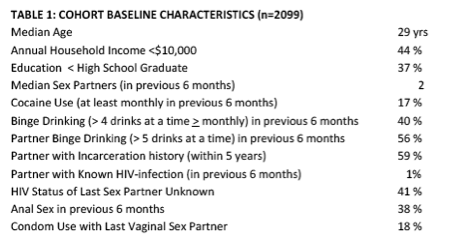
CONCLUSIONS: Recruitment from geographic 'hotspots' of HIV infection identified a cohort of US women with few partners but prevalent risk behaviors. Thirty-two women were newly diagnosed at enrollment and two more had acute HIV infection at enrollment. HIV incidence in HPTN 064 (ISIS) was substantially (5 times) higher than CDC 2009 annual HIV incidence estimate for US black women (0.05%) and comparable to estimated HIV adult incidence rates in parts of sub-Saharan Africa (Congo 0.28 % and Kenya 0.53%), underscoring the urgency of conducting prevention trials among women at risk for HIV infection in the US.
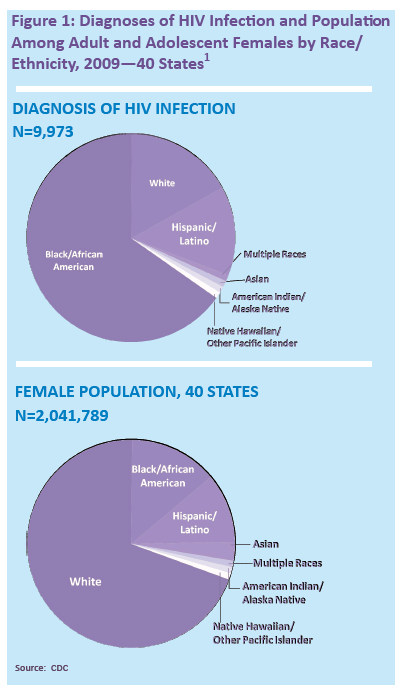
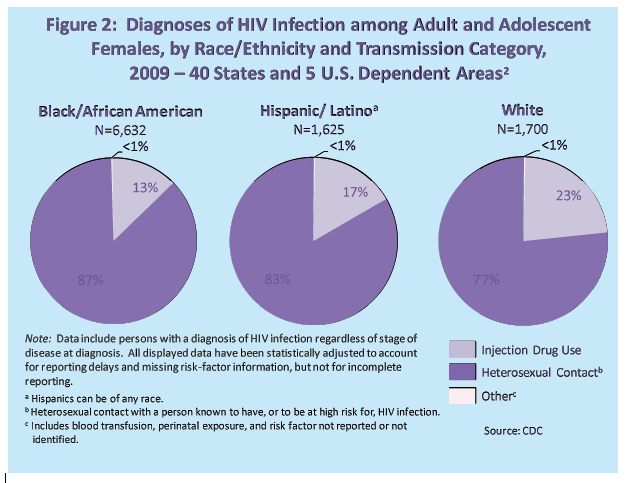
BACKGROUND
· Approximately 25% of new HIV infections in the US occur in women; 66% of those are in black women (Figure 1).1
· Women acquire HIV infection most commonly through heterosexual transmission (Figure 2)
· Limited availability of HIV incidence has impeded design of prevention interventions and trials for US women at risk for HIV acquisition.
· Past efforts have failed to identify populations of US women with sufficient HIV incidence to enable conduct of HIV prevention trials with an HIV incidence endpoint.
· We assessed HIV incidence and factors that may impact HIV risk among US women using novel recruitment strategies and innovative methods of incidence determination.
Study Design
· Multi-site, longitudinal cohort study with prospective and retrospective components.
· Eligible women were enrolled from 10 US communities (in six geographic locations) with relatively high reported HIV prevalence (Figure 3).
· Detailed ethnographic mapping identified recruitment venues frequented by women within areas of participating communities with high HIV
prevalence and poverty rates.
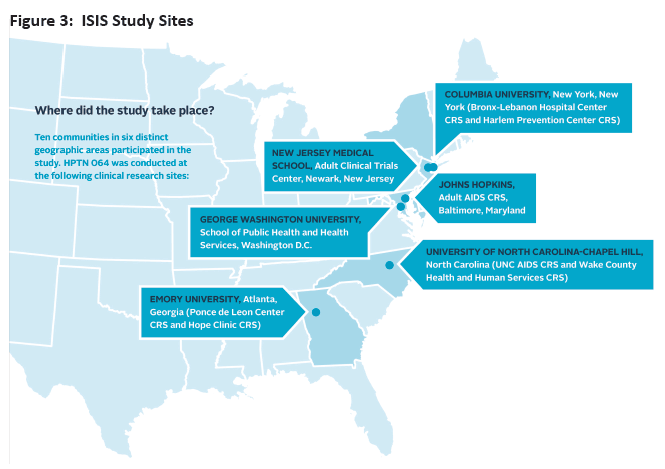
· Participants were followed from 6-12 months
· Rapid HIV testing at baseline and every 6 months
· Audio computer-assisted self-interviews (ACASI) at baseline, and every 6 months
- ACASI domains included: socio-economic factors, food insecurity, mental health (depression and post-traumatic stress disorder), perceived general health status, sexual behavior (including concurrency), history of sexually transmitted infections (STIs), domestic violence, and social support.
· Monthly phone contacts and updates of locator information encouraged.
· Qualitative substudy consisting of semi-structured interviews and focus groups was conducted in four communities.
· HIV incidence was assessed in four ways (See Poster W-229 for more details): Analysis of (1) recent infection at enrollment, among women who had a positive Western blot (WB) at enrollment (HIV+); recent infection was analyzed using a multi-assay algorithm (MAA, window period estimated to be between 3 and 9 months) that defines recent infection as BED capture immunoassay (BED) <1.0 normalized optical density units (OD-n) + avidity index <80% (using an avidity assay based on the BioRad 1/2+0 ELISA) + CD4 cell count >200 cells/mm3 + viral load > 400 copies/ml, (2) acute infection at enrollment (HIV RNA positive with an non-reactive EIA or a reactive EIA with a negative or indeterminate WB, identified using the ARCHITECT HIV Ag/Ab Combo HIV assay *COMBO+ or an unpooled HIV RNA assay), (3) HIV seroconversion (rapid testing with WB confirmation), and (4) acute infection at study exit (acute infection as defined above), identified using the COMBO assay).
Inclusion Criteria and Definitions
Eligible individuals were:
· 18 to 44 years of age.
· Self-identified as being a woman (transgender individuals were eligible).
· Had reported unprotected (i.e., without a condom) vaginal and/or anal sex with a man in the 6 months prior to enrollment.
· Resided in a census tract or zip code with high HIV prevalence and poverty (referred to as primary prevention area, PPA).
· Reported at least one of the following:
1. Individual risk factor: Reported one or more of the following in the past 6 months, except for incarceration which could have occurred within the past 5 years: a) illicit injection and/or noninjection drug use (e.g. heroin, cocaine, crack cocaine, methamphetamine, and/or prescription drugs used outside the oversight of a medical professional), b) alcohol dependence (defined as CAGE Score ≥ 2)3, c) binge drinking defined as four or more drinks at one time, d) incarceration (jail and/or prison ≥ 24 hours), e) history of self-reported STIs: gonorrhea, Chlamydia, trichomonas, or syphilis, f) exchange of sex for commodities (e.g. drugs, money, shelter).
2. Sexual partner risk factor: Reported male sexual partner in the past 6 months with a history of the following (in past 6 months, except for incarceration which could have occurred within the past 5 years): reported history of use of illicit injected or noninjected drugs, and/or STIs, and/or HIV seropositive diagnosis, and/or incarceration, and/or history of binge drinking defined as 5 or more drinks at one time and/or alcohol dependence (defined as CAGE Score ≥ 2)3.
Exclusion criteria
· Self-reported history of a previous positive HIV test.
· Current enrollment in an HIV prevention trial or current/past participation in an HIV vaccine trial.
· Intention to move or travel for more than two consecutive months during the follow-up period.
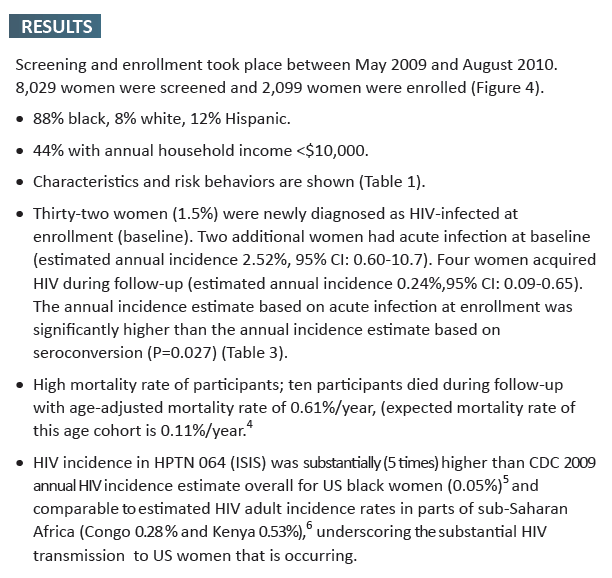
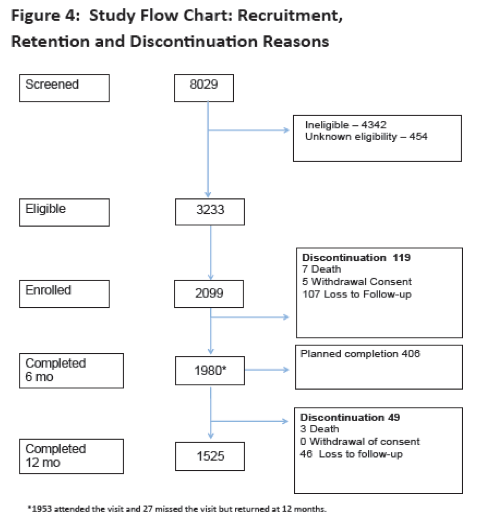
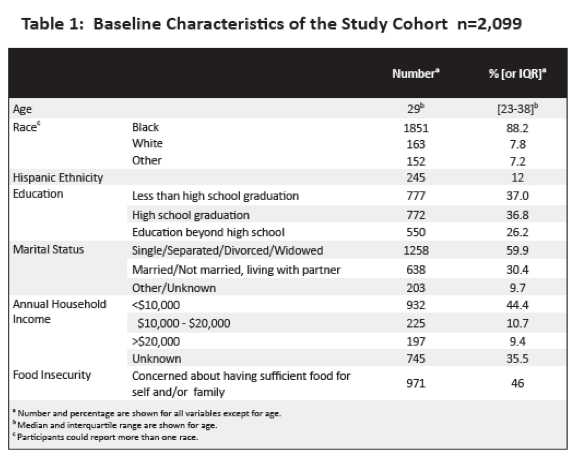
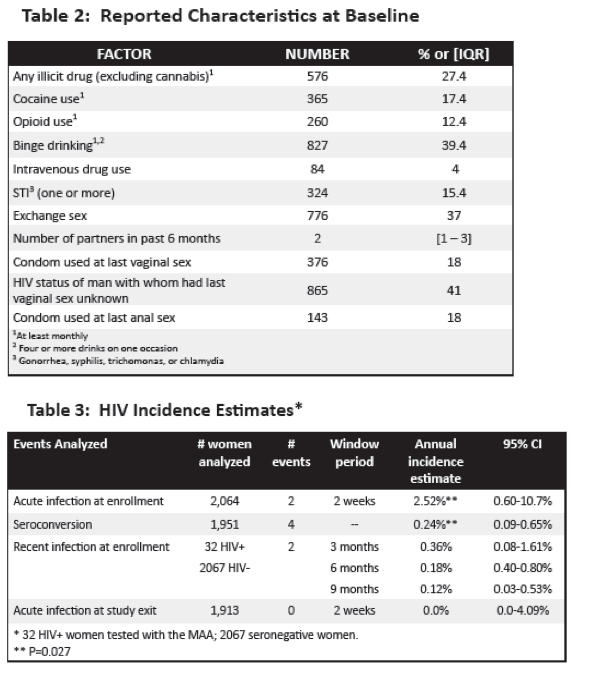
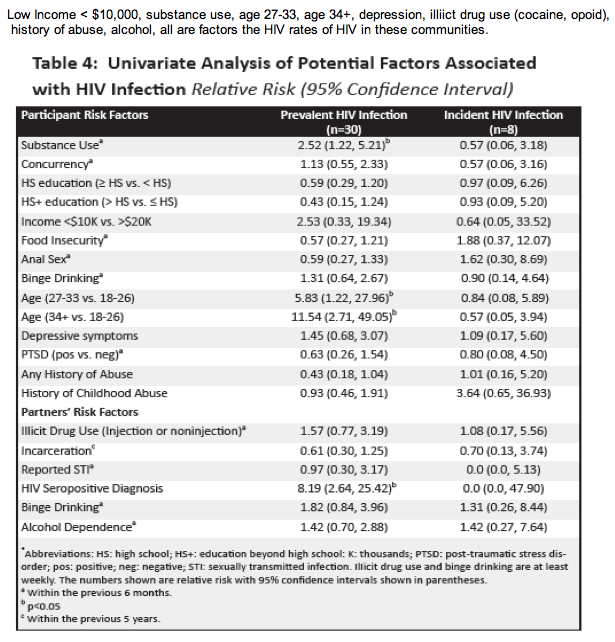
Limitations
· Few incident infections limited ability to identify specific risk factors associated with HIV transmission (Table 4).
· These results, are not generalizable to the general population of women as participant eligibility determined by geographic location and presence of personal or partner HIV risks.
22 March 2012
ISIS ENGAGE
Please join us for a study update including an inspiring poetry
performance and data/information sharing, with discussion following.
Virtual presentation begins promptly at 6pm EST
Dial-in # (US): (800) 683-4564
Participant Access Code: 935297
Please pre-register for the Live Meeting:
https://www.livemeeting.com/lrs/1100000838/Registration.aspx?pageName=q60c902l39gltb0n
For questions or for more information, email
isiswebinar@listserv.fhi.org
HPTN 064-The Women's SeroIncidence Study
|
| |
|
 |
 |
|
|